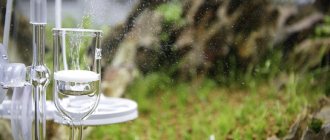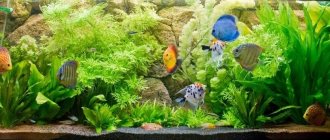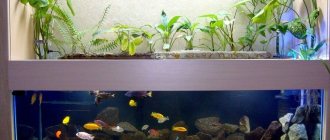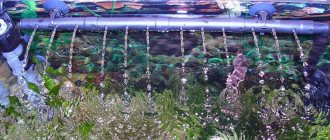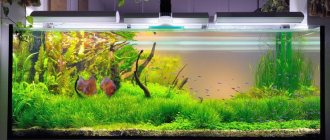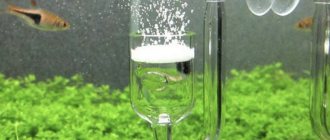Quickly navigate to the article
- 1 ROLE OF IRON IN AN AQUARIUM WITH PLANTS
- 2 TESTS FOR IRON IN THE AQUARIUM
- 3 WHAT ARE IRON AND WHAT CAN BE USED IN AN AQUARIUM
- 4 IRON CHELATES, THEIR STABILITY AND SUITABILITY FOR USE IN AQUARIUM
- 5 HOW TO PREPARE FERTILIZER WITH IRON WITH YOUR OWN HANDS
- 6 HOW MUCH TO ADD IRON WITH FERTILIZERS
- 7 AUTOMATIC SYSTEM FOR SUPPLYING THE OPTIMAL AMOUNT OF IRON INTO THE AQUARIUM 7.1 Other interesting articles
To prevent diseases and death of plants in the aquarium, timely changes of water, a sufficient amount of carbon dioxide and mineral feeding are necessary. One of the required components of the mineral supplement is iron, which is involved in the processes of respiration and growth of aquatic flora.
If you have reagents, you can prepare iron sources for aquarium plants with your own hands.
The role of iron in a planted aquarium
Iron (Fe) is involved in the production of chlorophyll, which facilitates the respiration process in green plants. The structure of this protein is similar to the structure of heme, which ensures the transfer and conversion of oxygen in human blood (hemoglobin). For heme, iron is the determining central atom, and for chlorophyll it is the catalyst for synthesis. Its place in the structure of the respiratory protein is taken by another macroelement - magnesium.
Iron-containing enzymes regulate redox processes during the synthesis of chlorophyll. They accelerate oxidative phosphorylation reactions and provide electron transfer due to the arbitrary valence of iron.
A lack of iron compounds also inhibits the production of natural plant growth stimulants - auxins. With a deficiency of chlorophyll, which absorbs green light and has a corresponding color, leaves turn yellow or discolored. The nutrient veins of the plant remain bright green. This process is called chlorosis (named after the chlorine ring that holds the magnesium atom in the protein structure).
With chlorosis, the leaves turn yellow, wrinkle and become more transparent. The disease affects the youngest leaves first. Discoloration of plants can also develop with a lack of magnesium, which forms respiratory protein. In this case, the old leaves turn yellow first, and the process begins from the edges and gradually spreads over the entire leaf area.
If leaf veins turn pale or yellow, the cause of chlorosis is a lack of sulfur or nitrogen, not iron.
The consequences of Fe deficiency develop in the following sequence:
- Yellowing of young leaves.
- Slowing down the growth of aquarium plants.
- The appearance of yellowness on all leaves, gradual discoloration of the flora.
- Death of plants.
Complex fertilizers and tap water contain insufficient amounts of iron, so it is recommended to prevent chlorosis using targeted fertilizers. Most often, target formulations contain a bound, bioavailable form of Fe—chelates.
Excess iron can also affect flora and fauna. A large amount of metal stimulates the growth of its active consumers – algae. The water in the aquarium takes on an unpleasant yellow tint, and a brown ferrous coating settles on the walls, equipment and in the gills of the fish. Clogged gills prevent fish from breathing, which leads to slow growth, early death, and absent or weak offspring.
Recipe No. 3. Aquarium feeding based on Ecoplant fertilizer
"Ecoplant" is a complex microfertilizer used to prepare soils for planting. It can be used to make an excellent food for aquarium plants. To do this, you need to take 0.1 g of Ecoplant and 5 ml of distilled water. The preparation looks like this:
- Ecoplant granules are crushed into powder;
- The powder is mixed with water and left for 1 hour.
The resulting suspension is drawn into a syringe and poured into the aquarium at the rate of 5 ml per 10 liters of aquarium water.
Practice shows that Ecoplant is positively perceived by aquarium plants and does not spoil the water:
“This fertilizer dissolves very slowly in water, so bacterial and algae outbreaks are excluded unless you overdose. I don’t even soak the powder in water, I throw it in dry form - 0.1 g per 10 liters. It slowly dissolves on its own. The plants feel great, and I don’t have to fertilize them every day” (Yulia, Novosibirsk).
Tests for iron in an aquarium
Tests for mineral content with regular fertilizing and water changes allow you to track its deposition and consumption in various forms.
The most common test kits are:
- UHE test Fe;
- TetraFe;
- Sera;
- NILPA Fe Test;
- Ptero Test Fe;
- VladOx Fe et al.
Some of them (Ptero, NILPA) determine only free forms of the metal, not oxidized or bound into complexes. As a result, the tests have limited applicability when iron chelates are used.
Even highly accurate tests that show the total concentration of all forms of a trace element (for example, UHE) can fail when strong binders (chelators) are used.
UHE Fe test for aquarium.
To find the balance of iron content, you need to focus on several factors at once:
- Fe level according to test. The normal range of its concentration is indicated in the instructions for the test kit. If the water change and the addition of a mineral supplement occurred more than 1-2 days ago, then it will not be possible to detect a sufficient level of iron. Most of the applied mineral will be oxidized or consumed by plants.
- Appearance of plants. Severe chlorosis will appear only with severe iron deficiency, but slight yellowing of leaves and stems will be visible already in the initial stages. With an increase in the dose of fertilizer, these leaves will quickly turn green. There is no need to take photos and videos of plants for comparison, because... the difference will be visible the next day. If there are no changes after a day, then the cause of yellowing and discoloration is a lack of magnesium, manganese and other micro- and macroelements.
- Iron application rates. Fertilizers can be applied in accordance with the universal norm or individual consumption indicator. To determine this indicator, you need to add iron at an average rate for 2-3 weeks and observe the color of the plants. Immediately after application and at the end of the week, iron levels should be measured with a high-precision test. The average or maximum result over several weeks can be taken as the consumption indicator.
If external indicators are normal and the recommended dosages are observed, you should not be afraid of a slight discrepancy in the numerical values. If there are signs of an overdose of Fe (algae growth, brown gills of fish), you should change the water, reduce the fertilizer application rate and add a composition with manganese to the aquarium. The latter will quickly clear the fish's respiratory tract and compensate for excess iron.
Rules for using homemade fertilizers for an aquarium
The wrong approach to using aquarium fertilizers can have a detrimental effect. This applies to both professional compositions and self-mixes. To avoid negative effects, you should adhere to the following rules:
- start using nutrient solutions with doses reduced by a quarter of the recommended;
- after adding the solution, monitor the condition of the water, plants and other aquarium inhabitants, gradually adjusting the dose;
- apply microfertilizers in the morning, half an hour before turning on the lights;
- do not use microfertilizers at the start-up stage of the aquarium until the nitrogen cycle has been established and the grass has taken root and started to grow;
- To avoid bacterial and algae outbreaks, never exceed the recommended dosage.
It is also worth keeping in mind that the effect of applying microfertilizers is not immediately visible. You can understand whether the composition used is suitable for plants about a month after you start using it.
What types of iron are there and which ones can be used in an aquarium?
Iron is a polyvalent element. This means that it can exhibit different degrees of oxidation in different compounds. Unlike calcium or magnesium, which form one hydroxide each, Fe can create one of two: Fe(OH)3 (for trivalent) or Fe(OH)2 (for divalent).
There is a common misconception among aquarists that aquatic plants only absorb divalent iron. In practice, trivalent Fe is inferior to divalent Fe in digestibility, but only slightly.
A more important condition for the absorption of iron is its free form. When released into the water and soil of an aquarium, the microelement quickly oxidizes, forming oxides that settle on the walls of the container. Plants cannot decompose and process oxides and hydroxides, so they only absorb the iron that they managed to obtain before the oxidation process was completed.
Given the intensity of the reaction, free iron should completely disappear from the water within several hours after addition. However, anaerobic soil microorganisms return part of the trace element to free form, reducing oxides and hydroxides.
Anaerobic bacteria do not provide sufficient concentrations of iron, so free Fe is treated with chelators to prevent oxidation initially. Chelators bind the metallic substance, but remain bioavailable and allow plants to absorb it as needed.
Fe concentration tests are based on the principle of oxidation, so they are good at detecting free divalent and trivalent metal, but do not react to bound material. Reagents for high-precision tests are capable of oxidizing iron even in weak chelates, initiating an ionic reaction due to higher activity.
When using strong chelators, exchange becomes impossible, and the accuracy of the result decreases.
Features of liquid fertilizers for aquariums
Recently, liquid fertilizers have become increasingly in demand. Questions regarding their use are specific. Moreover, in most cases, aquarium owners ask: “is it possible to use macro- and microfertilizers at the same time?” The nature of this issue is completely clear.
Phosphate from a mixture of macroelements can be the basis for the creation of insoluble compounds, which include cations of a mixture of microelements. However, this opportunity appears only if you mix liquid macro- and microfertilizers. If you initially add the products to the aquarium, you can understand that the components will be greatly diluted. Subsequently, the creation of insoluble compounds ceases to be possible. For this reason, to change the components of fertilizers, care must be taken to simultaneously use macro- and micro-components.
It is believed that macroelements are best consumed by green spaces at night, so it is recommended to apply such components in the evening so that they can show maximum benefit. This statement can be found on numerous forums for lovers of aquarium fish and plants. However, the recommendation is questionable: the absorption of nutritional components occurs only with the receipt of light, therefore liquid micro- and macro-fertilizers are best applied early in the morning.
Previously, fertilizer manufacturers recommended adding nutrient mixtures once a week. Most likely, such advice was based on a certain laziness of aquarists, because manufacturers did not want to scare off the target audience. Despite this, the products of Ermolaev and other developers should be introduced regularly and evenly. Daily use of fertilizers can provide decent results, which can never and under no circumstances be achieved when the procedure is carried out once a week.
Iron chelates, their stability and suitability for use in aquariums
Several chelated iron compounds are used in the aquarium industry. They differ in the formula of the acid residue, the method of production, durability and effect on the microflora of the aquarium. Most of them are easy to obtain at home.
Common Fe chelates for aquarium plants:
| Fe chelate | What is it used to obtain (chelator substance) | Durability | Connection Features | Consequences of use in an aquarium |
| Citrate | Lemon acid | weak | Are unstable but cheap chelates Suitable for frequent application | Well decomposed by bacteria |
| Glycinate | Glycine (amino acetic acid) | weak | Actively eaten by microflora The action is similar to gluconate, but does not give an immediate effect | |
| Gluconate | Gluconic acid | weak | Daily application is required. If forced herbals are delayed, signs of chlorosis quickly appear. | As a quickly digestible carbohydrate, it is easily consumed by bacteria Provides an ultra-fast effect in case of iron deficiency (leaves turn green within 1-2 hours after application) |
| Fumarate | Fumaric acid | average | Used less frequently than other weak and moderately stable chelates | Decomposes by microorganisms, does not accumulate in water |
| Fe-EDTA | EDTA (ethylene-diamine-tetra-acetic acid, Trilon-B) | High (at pH>7 weak) | Remains stable in soft water with a stable supply of carbon dioxide (CO2) When decomposed, binds calcium and magnesium ions | Decomposing in hard water (pH>7), it causes a lack of macroelements and radiculitis in plants. Residues of Fe-EDTA are not consumed by bacteria, which aggravates its accumulation in the aquarium |
| Fe-HEDP | Etidronic acid | high | Remains stable at pH>7 It is a source of phosphorus; with regular use, it requires adjustment of the phosphate dose Activates the growth of aquatic flora | Decomposed by the microflora of the aquarium, does not cause radiculitis of aquatic plants. High concentration of phosphates and uneven consumption of CO2 leads to the appearance of green algal plaque |
| Fe-DTPA | DTPA (diethylene triamine tetra acetic acid) | high | Remains stable at pH>7 | Compared to Fe-EDTA, it is more actively consumed by soil bacteria and has a weaker effect on the concentration of macroelements. Signs of radiculitis may appear on forced plantings (with large doses of fertilizers). |
Chelate compound Fe-HEDP.
The choice of chelate depends on the purposes of growing plants, financial capabilities and frequency of fertilization:
- for an amateur home aquarium, you can use inexpensive and safe chelates - iron citrate and glycinate;
- Fe-EDTA is easily obtained at home, but due to side effects it is of limited use in the aquarium hobby;
- when growing aquatic plants for sale, you can introduce part of the iron in the form of Fe-HEDP: this chelate will accelerate their growth due to the large amount of phosphorus;
- To improve microflora and optimal bioavailability of iron, combinations of weak and stable chelates (for example, ferrous gluconate and Fe-DTPA) are effective.
When using stable compounds, it is necessary to change the water at least once a week.
How often should liquid fertilizer be applied?
Despite the assurances of manufacturers that once a week is enough, daily feeding still has a much better effect on plants. For this purpose, it is necessary to evenly distribute the weekly dose of fertilizer into 7 doses or follow the instructions.
If you are planning a long trip and want to keep your plants safe and sound, then try reducing the nutritional requirements of your greens. To this end, do the following:
- It is necessary to reduce the amount of CO2 so that the pH is within the acceptable range of 7-7.5;
- Reduce lighting by half;
- Lower the water temperature by 1-2 degrees;
- On the day of departure, feed the plants with a weekly dose of fertilizer.
How to make fertilizer with iron yourself
To prepare iron chelates yourself, you can use the following methods:
- With citric acid. To obtain the fertilizer, you need to take 500 ml of distilled water, 20 g of iron sulfate from a garden store and 20 g of anhydrous citric acid. Mix acid and water. After dissolving the citric acid, you need to carefully add vitriol and mix. The resulting light yellow solution has an iron concentration of about 7.5 mg/ml. Citrate should be stored in a container with darkened walls. Recommended storage period is 2 weeks. Darkening of the solution indicates a decrease in its effectiveness.
- WITH EDTA. Take 1 liter of distilled water, 2.5 g of iron sulfate and 5 g of Trilon-B (Complexon-3). You can buy Trilon-B at a flea market for photo reagents, in a pharmacy or in a laboratory chemical reagents store. Mix all components and add 0.5 g of ascorbic acid to better preserve the solution. The iron concentration in this solution is 0.5 mg/ml. It will not be possible to obtain less harmful fertilizers with DTPA and HEDF at home, because these chelators are rarely sold at retail.
Commercial chelates based on trivalent Fe may be poorly soluble in water. To restore the metal to divalent, you can use powdered ascorbic acid. If the resulting solution is too acidic or the water in the aquarium is initially soft, then the fertilizer can be neutralized with potassium carbonate (potash). The proportion of components is selected in accordance with the coefficients of the chemical reaction.
An acidic environment increases the absorption of iron, so citric acid can also be added to reduce water hardness.
Yellowed plant leaves
Yellowed leaves of plants in the aquarium indicate a lack of iron. Iron is the most important microelement in plant nutrition
It is important to ensure its constant presence in the aquarium water. To eliminate iron deficiency, use, for example, iron supplementation (Fe+Mn)
Take an aquarium water iron test and check the iron concentration in your aquarium water. Using Micro, as well as feeding Fe+Mn, bring the iron concentration to 0.1-0.2 mg/l. If there are no tests, feed Fe+Mn in a volume of 1 ml/100 liters daily
Please note that iron must be in the correct ratio to manganese (2.5 to 1)
Iron and manganese (Fe+Mn). Of course, all aquarists of any level of knowledge are aware of the critical role that iron plays in the life of a plant. In fact, a complete supply of plants with iron in a form that is digestible for them is 15% of successful plant growth (we believe that 80% of success depends on high-quality nutrition with macroelements, 15% with iron and 5% with microelements). Iron plays a vital role in photosynthesis (night phase), is part of proteins, and participates, along with molybdenum, in the reduction of nitrate. The lack of iron is especially acute when growing plants in a closed system (which is what an aquarium is).
How much iron to add with fertilizers
The amount of fertilizer is calculated depending on the volume of the aquarium. For every liter of water you need to add 0.5-1 mg of iron per week. For aquariums without carbon dioxide supply, this norm may be less, and with increased water hardness it can reach up to 1.5 mg. When supplying CO2, it is recommended to apply fertilizer daily (1/7 of the weekly dosage).
An increased content of calcium and phosphorus leads to soil depletion and a decrease in iron concentration. Both elements bind it into insoluble compounds, making it inaccessible for absorption. With regular addition of phosphates and high water hardness, it is necessary to control the level of Fe and the appearance of the aquatic flora.
Some aquarists insist that 0.5-1 mg is the peak application level needed early in the aquarium's life and when signs of chlorosis develop. The normal concentration of the microelement is 0.1-0.3 mg/l.
An overdose above 2 mg/l is dangerous for plants and fish. It can occur with a high initial concentration of Fe in water (for example, from a well), excessive feeding, or a combination of these factors. The growth of aquarium flora in such conditions slows down.
Recipe No. 1 (NPK fertilizer for aquarium plants)
| Nitrogen fertilizer | Phosphorus fertilizer | Potassium-containing | ||
| N * (g/l) | K (g/l) | P *(g/l) | K (g/l) | K (g/l) |
| 11,5 | 32 | 1,6 | 2,01 | 38 |
| * - I personally find it more convenient to calculate fertilizers in the form of N and P, but aquarists find it more convenient when nitrogen is presented in the form of nitrates, and phosphorus in the form of phosphates. Therefore, for convenience, I have indicated the values of nitrates and phosphates in parentheses. |
I recommend that when making fertilizers for aquarium plants according to this recipe, do not do everything in “one bottle”, but do it in different bottles in order to be able to make adjustments in dosage if necessary.
The fact is that plants do not consume nutrients evenly and imbalances in nutrition may occur, which can lead to algae outbreaks. Also, the concentration of nitrogen and phosphorus in water is affected by aquarium animals, which release these elements during their life activities. From the editor: Starting an aquarium from A to Z
Nitrogen fertilizer
To prepare a fertilizer containing nitrogen (in the form of nitrates), you need to dissolve 82.88 grams of potassium nitrate in 700 ml of water. After complete dissolution, add water to the resulting solution to the 1000 ml mark.
1 ml of this fertilizer increases the concentration of potassium by 0.64 mg/l and nitrogen by 0.23 mg/l (or 1.02 mg/l nitrates) in 50 liters of water: Approximate application schedule and dosage of fertilizer
Phosphorus fertilizer
To prepare a fertilizer containing phosphorus (in the form of phosphates), you need to dissolve 7.01 grams of potassium monophosphate in 700 ml of water. After complete dissolution, add water to the resulting solution to the 1000 ml mark.
1 ml of this fertilizer increases the concentration of potassium by 0.04 mg/l and phosphorus by 0.03 mg/l (or 0.1 mg/l phosphates) in 50 liters of water: Approximate application schedule and dosage of fertilizer.
Potassium fertilizer
To prepare a fertilizer containing potassium, you need to dissolve 84.76 grams of potassium sulfate in 700 ml of water. After complete dissolution, add water to the resulting solution to the 1000 ml mark.
1 ml of the resulting fertilizer increases the concentration of potassium in 50 liters of water by 0.76 mg/l: Approximate application schedule and dosage of fertilizer.
Automatic system for supplying the optimal amount of iron to the aquarium
The absorption of iron by aquatic plants occurs only under the influence of UV rays. In order to apply fertilizers in a timely manner and not make a mistake with their quantity, you can purchase an automatic dispenser. These devices are designed for several different additives at once, which allows you to provide the aquarium with all the necessary macro- and microelements.
The cost of an automatic application system ranges from 3 to 10 thousand rubles. depending on the manufacturer. If you have a dispenser, a set of tubes and a controller, you can assemble such a system at home.
Bookmarks 0
Choosing between homemade aquarium fertilizers and branded ones
Among aquarists there are supporters of using both homemade aquarium fertilizers and branded ones. Why do some people prepare fertilizers with their own hands, while others buy branded ones? Of course, the main advantage of homemade fertilizers is their price. The cost of such fertilizers may differ significantly from the price of branded fertilizers. My recipe for homemade aquarium fertilizers indicates the prices of chemical reagents, which will allow you to understand what the cost of such fertilizers is. However, you will have to buy chemicals in quantities that you may not be able to use over the entire time you have been interested in plant aquariums. Therefore, initially you will have to invest more in chemicals than in branded fertilizers. The path of using homemade fertilizers is usually taken by those aquarists who have a good basic knowledge of school chemistry and are generally interested in the chemistry of a planted aquarium and are keen on experimenting with their aquarium plants. Branded fertilizers are becoming the choice of aquarists who are more interested in the aesthetic side of plant aquarium keeping and experiments with preparing fertilizers seem to them like an extra headache and a waste of time. In addition, branded fertilizers are constantly being improved because manufacturers have financial motivation to do so. Public recipes for homemade fertilizers are usually unchanged and their improvement remains the responsibility of those who use them. Branded fertilizer formulas include various additives that improve their storage. While homemade fertilizers are easier to re-prepare than to improve their resistance to fungus and mold. For the same reason, homemade fertilizers are best stored in the refrigerator or frozen.
Leaves turn yellow from the beginning of the leaf to the base
The leaves turn yellow from the beginning of the leaf to the base (and then dissolve in this order) - these are signals of nitrogen deficiency. Nitrogen is the most important macronutrient. A significant amount of it can be in aquarium water and in fish waste products. It is necessary to test the water for nitrate using aquarium tests.
Take an aquarium water nitrate test and check the concentration of nitrate in the aquarium water. Using Macro NPK or Macro N+K, adjust the nitrate concentration to 5-10 mg/l. Watch the ratio of nitrate and phosphate! We recommend keeping the ratio 1 to 10 (phosphate to nitrate) for ease of remembering.
Nitrogen (N) is one of the cornerstones, an organic element (only oxygen, hydrogen, carbon and nitrogen are considered as such, which together account for 95% of the plant’s mass). The plant uses nitrogen both in the form of nitrate and in the form of ammonium and ammonia, which are directly involved in this form in a number of vital processes.
Macroelements are those chemical elements whose content in living organisms ranges from 80 to 0.01% of the body’s weight. These are oxygen (O), carbon (C), hydrogen (H), nitrogen (N), phosphorus (P), potassium (K), sulfur (S), chlorine (Cl), calcium (Ca), magnesium (Mg), sodium (Na). Hydrogen, oxygen, carbon and nitrogen account for about 98% of living matter. These four elements, together with sulfur and phosphorus, are often called bioelements, because. they are necessary components of molecules of biological polymers (from the Greek polys - many; meros - part): proteins, nucleic acids, carbohydrates and lipids. In an aquarium, we are particularly interested in four macroelements, namely carbon, nitrogen, phosphorus and potassium. Oxygen and hydrogen are provided by the environment itself, sulfur and chlorine are very common anions, their supply is often excessive (in the form of sulfates, chlorinated water, etc.), magnesium, calcium and sodium are present in excess in tap water, and in the case of using osmosis - in a remineralizer.
How to store
You can purchase ready-made iron chelate powder in the store and use it to prepare the solution yourself. In a sealed package it can be stored for up to one and a half years. The air temperature is allowed from 0 to +30 degrees. The room should be well ventilated and not damp. The packaging with the drug should not be exposed to direct sunlight.
Home remedies prepared with your own hands should be used on the same day, since working solutions cannot be stored for more than a day. Otherwise, the iron chelate loses its properties.
How much and what does anyone need?
This is the most frequently asked question - I have a 200 liter aquarium, how much fertilizer should I use? It is impossible to give an exact answer to such a question, since it depends on many factors.
- Number of plants in the aquarium - a single blade of grass and a dense forest require different amounts of added fertilizer
- Plant species - fast-growing Hygrophylla requires many more elements than the slow-growing Java fern.
- The amount of light and carbon dioxide in an aquarium - a brightly lit aquarium in which you add carbon dioxide, where photosynthesis occurs so that oxygen is bubbling, needs more fertilizer than an aquarium where there is little light. The permissible level of nitrates and phosphates also depends on this, an excess of which in water is usually the cause of the appearance of algae. For example, in an aquarium - a dark kingdom, nitrates can reach 10-20 mg/l, and phosphates - 1-2 mg/l, without algae growing, and in a rapidly growing aquarium, problems can begin already at 10 mg/l l nitrates and 0.2-0.5 mg/l phosphates. It should be noted that if your plants grow quickly, then the level of nitrates and phosphates is usually zero and you have to add nitrates (one of the methods of combating algae is based on this).
- Temperature and other water parameters - if they are not optimal and the plants grow poorly, then there is no point in adding fertilizers.
- The presence of certain elements in water. For example, if there is a deficiency of any element, the plant is unable to absorb other elements. With an excess, a similar picture is observed.
- And the main reason is that we don’t know how much a plant needs of one or another element. The table below shows the optimal values of micro and macroelements for plant growth. But these are weight values in the dry mass of the plant, and not in reality, in aquarium water
| C (Carbon) | about 45% |
| N (Nitrogen) | 1-3% |
| K (Potassium) | 0.3-6% |
| Ca (Calcium) | 0.1-3.5% |
| P (Phosphorus) | 0.05-1% |
| Mg (Magnesium) | 0.05-0.7% |
| S (Sulphur) | 0.05-1.5% |
| Fe (Iron) | 10-1500 ppm (parts per millions) |
| Cl (Chlorine) | 100-300 ppm |
| Mn (Manganese) | 5-1500 ppm |
| Zn (Zinc) | 3-150 ppm |
| Cu (Copper) | 2-75 ppm |
| B (Boron) | 2-75 ppm |
| Mo (Molybdenum) | footprints |
As can be seen from the table, the values of some elements fluctuate many times. Therefore, it is impossible to give an exact answer to this question. General recommendations for the most important elements can be given as follows:
Phosphates - the test should not show the presence of phosphates. At the same time, plants are able to absorb the most insignificant amounts of them in water. If there is no measurable amount of phosphate in the water, you will have fewer algae problems. This is the main reason why you cannot add fertilizers for indoor plants to water. Fish will provide a sufficient amount of phosphates - phosphorus is part of organic matter and, when it decomposes, becomes available to plants. If you keep few fish, you can add a little fertilizer containing slowly soluble phosphates (for example, palm fertilizers) to the soil, but in no case to the water, where they will be available to algae. But in the vast majority of cases this is not necessary.
Nitrates - Nitrate levels should be kept at approximately 2-5 mg/l. The presence of a small amount of nitrates is good because in this case the plants absorb phosphates without leaving them for algae.
Potassium - you can have more of it. It does not cause algae development. Therefore, it is often placed by eye. There is no exact opinion in assessing the optimal concentration; approximately 20-50 mg/l is accepted. There are tests to measure potassium concentration, but they are expensive and difficult to use because they rely on measuring the agitation of the water. Potassium is usually added in the form of sulfates or nitrates (if you are adding nitrates).
Iron is one of the most important trace elements that is usually deficient in an aquarium. Its deficiency leads to chlorosis, when chlorophyll is not formed in the leaves and they look pale yellow. The approximate optimal iron concentration is about 0.1 mg/l. Higher levels can lead to the growth of algae, especially filamentous algae. In the future, you should maintain approximately the same level of iron
If there is no test for iron, you should add especially carefully, since you can easily overdose
Effects of excess iron
Long-term excess iron can have serious health consequences.
Symptoms of excess iron in the body include drowsiness and fatigue. As with other nutrients, excess iron will also be felt in our digestive tract and vomiting, nausea and diarrhea may occur. Eventually, iron will begin to accumulate in the internal organs and damage them, leading to a gradual loss of function.
A damaged pancreas stops regulating carbohydrate metabolism, which leads to diabetes. Liver cirrhosis, intestinal necrosis, and joint inflammation and pain may occur.
Holes in leaves
Holes in the leaves that widen and turn yellow at the edges indicate a potassium deficiency. Potassium is an important macronutrient that must be supplemented, since it does not exist in organic form and its deficiency is quite common.
Macro K should be added to the aquarium water at a rate of 10 mg/l per week for a remineralized osmosis aquarium and 20 mg/l for a tap water aquarium. It is applied both as part of complex macrofertilizers (Macro NPK, Macro P+K, Macro N+K), and as a monocomposition (Macro K) or together with microelements (Micro plus K) and H2O + remineralizer. Potassium is not a limiting factor, so there is no need to constantly test it, but you just need to calculate its amount for your aquarium once.
Potassium (K) is an important transport agent, a regulator of the water pump in the plant, and also performs a number of other important functions. Its constant presence in aquarium water is necessary, without strict quantitative limits, since it is not a limiting factor
In this case, you need to pay attention to the concentration, since a potassium overdose is possible. It is generally accepted that its concentration in water should correlate with nitrogen in a ratio of 1 to 1.5, but at the same time its quantitative consumption is lower, since in fact potassium is not a building material for cells


